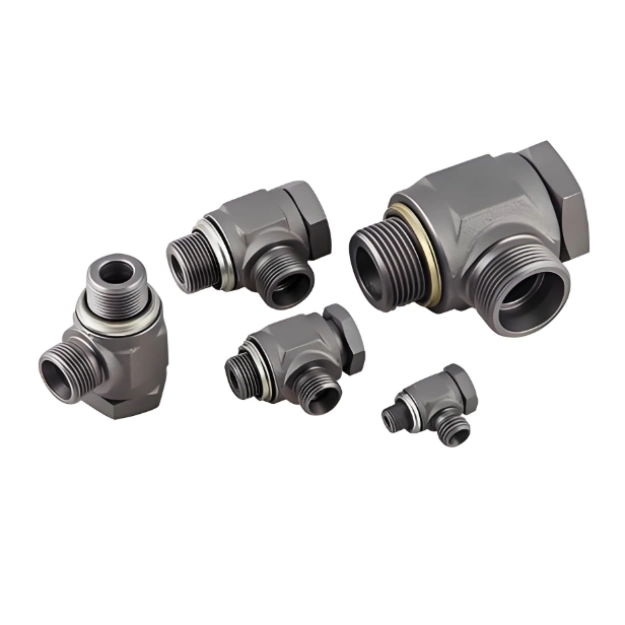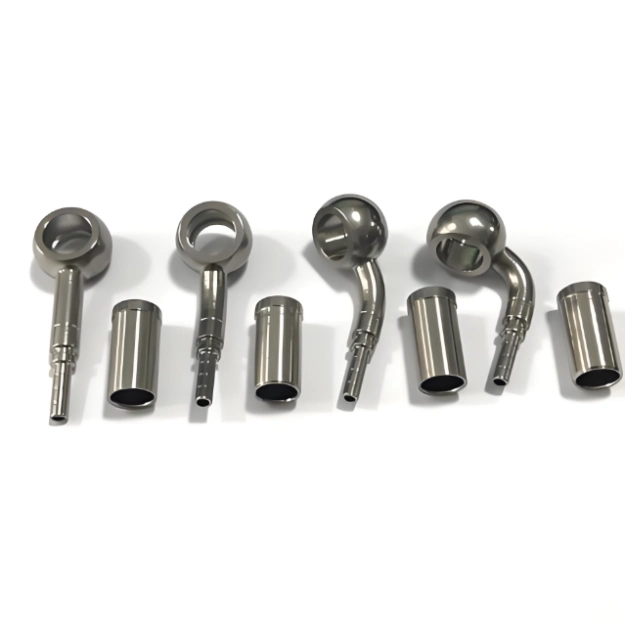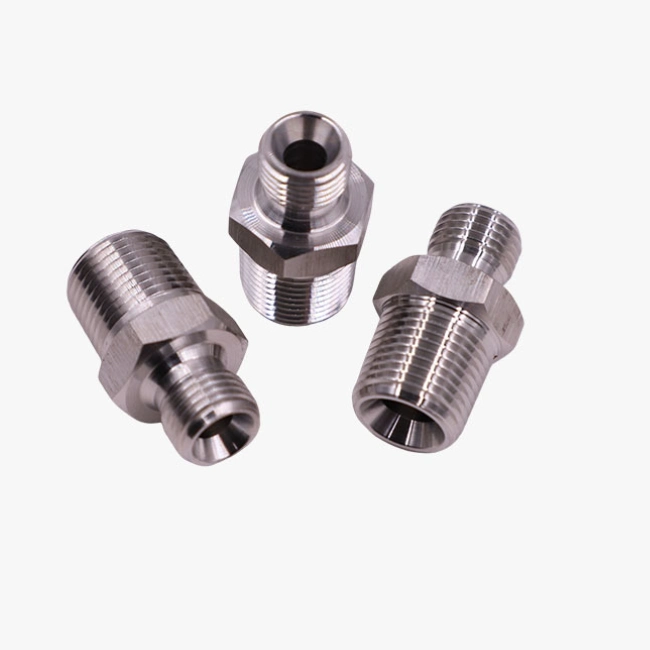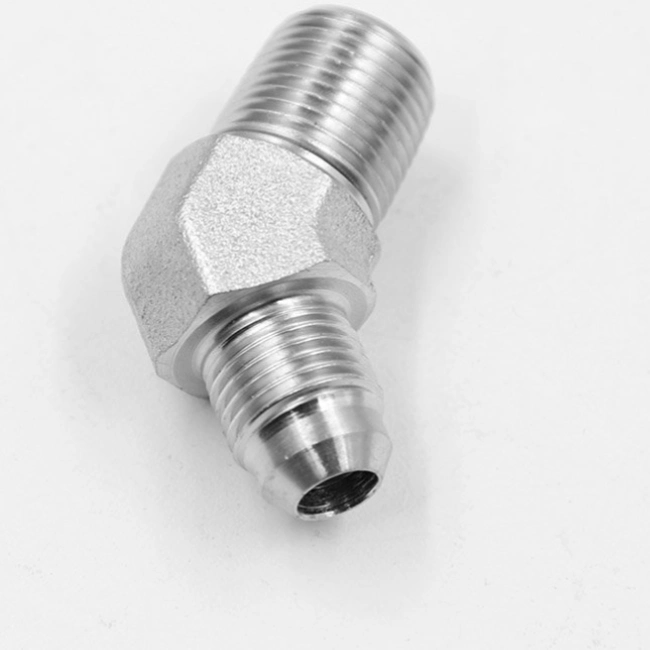What is a Banjo Fitting?
Banjo Fitting, also known as Hydraulic Steering Fitting or Hollow Bolt Fitting, is a special connection used in hydraulic systems, named for its resemblance to the musical instrument “banjo”. It is mainly used to change the direction of the pipeline, while maintaining high-pressure sealing performance.
Main features of banjo fittings
The structure of banjo fittings consists of:
Hollow bolt (with center hole)
Connection body (L- or T-shaped steering structure)
Sealing gasket (copper, aluminum or composite)
Banjo Fittings Advantages:
Suitable for tight spaces, saving installation locations.
Withstands high pressures (typically 3000~6000 PSI).
Allows efficient diversion of fluid, reducing pressure loss.
Banjo Fitting Disadvantages:
More prone to loosening due to vibration than straight-through fittings.
High sealing requirements, damaged gaskets can easily lead to oil leaks.
Banjo Fittings Common Model Specifications Parameters
| Standards | Applicable Regions | Features |
| SAE (JIC) | American Standard | 60° Taper Seal for High Pressure |
| BSPP (G Thread) | British Standard | Parallel Threads + Gasket |
| JIS | Japanese Standard | similar to BSPP, common in construction machinery |
| DIN | European Standard | Metric Threads, High Pressure Resistant |
Key parameters of banjo fittings
Thread size: such as 1/4” NPT, M12 × 1.5
Orifice (ID): e.g. 6mm, 8mm (affects flow rate)
Pressure rating: e.g. 3000 PSI, 420 bar
Material: carbon steel, stainless steel (304/316), brass
Banjo Fittings Usage
Banjo fittings are used in a wide range of hydraulic systems where compact steering connections are required, typical scenarios include:
Construction machinery (hydraulic lines for excavators, loaders)
Agricultural equipment (hydraulic steering systems for tractors)
Injection molding machines (high pressure manifolds)
Marine/aerospace hydraulics (corrosion resistant stainless steel)
Banjo Fittings Compatibility Analysis
Interchangeability of Banjo Fittings to Different Standards
SAE vs JIS: partially interchangeable, but different sealing angles (SAE 60° vs. JIS 30°).
BSPP vs. NPT: not directly interchangeable, different thread types (parallel vs. tapered).
Metric vs. Imperial: check pitch and diameter (e.g. M12 x 1.5 ≠ 1/2” NPT).
Alternatives to Banjo Fittings
If space permits, 90° elbows + straight fittings can be substituted, but may add bulk.
Hose steering fitting (more flexible, but lower pressure resistance).
Banjo Fittings Sealing Mechanism
The sealing of banjo fittings mainly relies on gasket compression, common sealing methods:
- Metal gasket (copper/aluminum)
Advantages: high pressure resistance, high temperature resistance
Disadvantages: one-time use, need to be replaced after disassembly - Composite gasket (rubber + metal)
Advantages: good elasticity, can be reused
Disadvantages: long-term high pressure may be deformed
3.O-ring seal (some high-end models)

Banjo Fittings common seal failure causes:
Gasket not aligned or installed backwards
Over-tightening leads to gasket collapse
Damaged threads cause leakage
How to install banjo Fittings
Steps for proper installation of banjo fittings
- Clean threads and contact surfaces (avoid contaminants that could affect sealing).
- Place the gasket (make sure it matches the fitting and is not offset).
- Pre-tighten manually (to avoid thread misalignment).
- Tighten to torque value (refer to manufacturer’s data, e.g. 30 N-m).
- Pressure test (check for oil leakage).
Notes on installation of banjo fittings
Prohibit the use of raw material bands (may block the oil circuit).
Avoid over-tightening (causes gasket deformation or thread slippage).
How to choose banjo fittings?
| Factors | Selection Advice |
| Pressure Rating | 20% above maximum system pressure |
| Materials | Carbon Steel (economical), Stainless Steel (corrosion resistant) |
| Standard Matching | Consistent with original equipment (SAE/JIS/BSPP) |
Hydraulic Banjo Fittings Frequently Asked Questions
What about oil leaks at fittings?
-Possible causes: Damaged gasket, worn threads, not tightened.
-Solution: Replace gasket, check threads, reinstall at standard torque.
Is it possible to reuse old gaskets?
Not recommended, metal gaskets lose sealing properties when compressed and it is recommended to replace them after each disassembly.
Hydraulic system pressure drops after installation?
-Check: for blockage (e.g. gasket misalignment), matching of orifice diameters.
Vibration causing joints to loosen?
Preventive measures: Use anti-loosening gaskets or thread locking compounds.
Summarizing
Banjo fittings are critical steering connections in a hydraulic system, and proper selection, installation and maintenance directly affect system reliability.
Selection points: matching standards, pressure resistance, material.
Installation key: gasket alignment, torque control.
Maintenance suggestion: check the sealing regularly to avoid vibration loosening.
Through this article, you can fully understand the technical details of the banjo fittings, and effectively solve problems in practical applications, if you have other questions about banjo fittings can contact our technical engineers, will be free to answer your questions.





